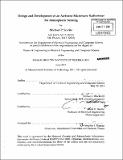Design and development of an airborne microwave radiometer for atmospheric sensing
Author(s)
Scarito, Michael P
DownloadFull printable version (12.64Mb)
Other Contributors
Massachusetts Institute of Technology. Dept. of Electrical Engineering and Computer Science.
Advisor
William J. Blackwell and David H. Staelin.
Terms of use
Metadata
Show full item recordAbstract
Satellite-based passive microwave remote sensing is a valuable tool for global weather monitoring and prediction. This thesis presents the design and development of a low-cost airborne weather sensing instrument to independently validate a satellite-based sensor platform. The NPOESS Aircraft Sounder Testbed - K-band (NAST-K) is a passive microwave radiometer operating over approximately 200 MHz bandwidth centered at 23.8 GHz and 31.4 GHz, whose data can be used to find surface water, humidity, and temperature conditions. NAST-K flies along with the existing NAST-M instrument at an altitude of 18 km in the NASA ER-2 high altitude aircraft. The primary function of NASTK is to provide coverage of channels 1 and 2 of the Advanced Technology Microwave Sounder (ATMS) aboard the NPOESS Preparatory Project (NPP) satellite, scheduled to be launched in October 2011. The combined NAST-M/K system can validate the performance of ATMS on all channels with data products up to 17km, by underflying the satellite along the same ground track and collecting correlated data. NAST-K has fullwidth at half maximum beamwidths of 7.4° and 6.8° for the two channels respectively, which is approximately consistent with NAST-M. The effective spot size of NAST-K is 2.3km in diameter for the wider 23.8GHz channel at nadir, providing an areal resolution approximately 1000 times greater than ATMS. The major contributions of this thesis include the system-level design of NAST-K, the development of the video amplifier and embedded environmental monitor, and the analysis of the antenna system.
Description
Thesis (M. Eng.)--Massachusetts Institute of Technology, Dept. of Electrical Engineering and Computer Science, 2011. Cataloged from PDF version of thesis. Includes bibliographical references (p. 103-105).
Date issued
2011Department
Massachusetts Institute of Technology. Department of Electrical Engineering and Computer SciencePublisher
Massachusetts Institute of Technology
Keywords
Electrical Engineering and Computer Science.